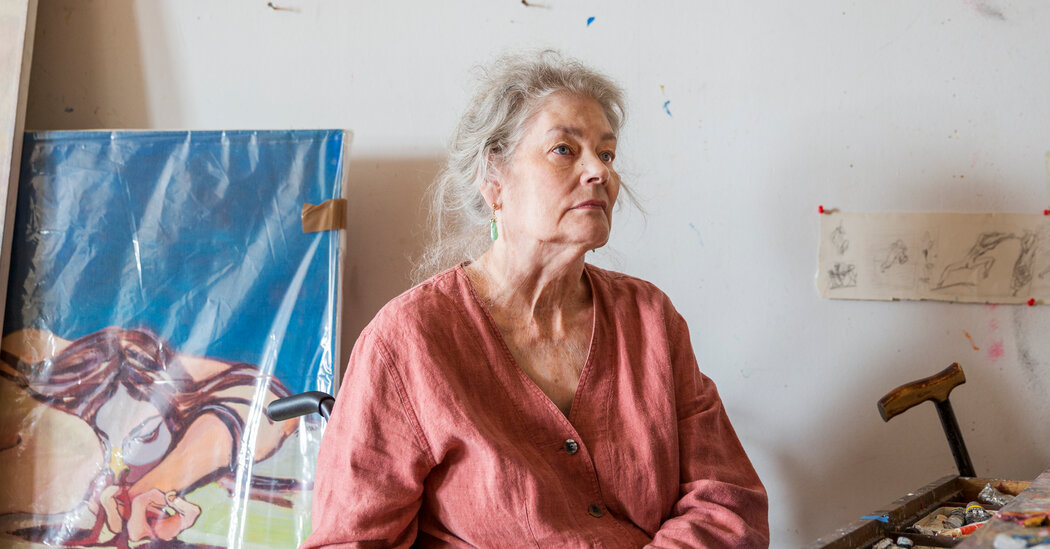
Her searing paintings, which could be sweet but also brutal, reflected her interest in the female body and what it could do.
Juanita McNeely, an uncompromising painter who used the language of Expressionism to immortalize the sweetest and most brutal moments of her own female experience, died on Oct. 18 in Manhattan. She was 87.
Her death, at Lenox Hill Hospital, was confirmed by her husband and only immediate survivor, Jeremy Lebensohn.
Ms. McNeely’s work was often intense. But the most searing single piece might have been her record of the fragmentary details — emotional as well as physical — of an abortion she underwent in the 1960s. She had been admitted to a hospital for treatment of a tumor when doctors discovered she was pregnant.
Because the pregnancy threatened her life, but with abortion illegal at the time, the doctors prevaricated, argued, even proposed saving the fetus and letting her die. She eventually did receive the procedure she needed, at a different hospital — but the experience left marks.
In the central panel of her “Is It Real? Yes, It Is!,” a polyptych of nine canvases arranged in a 12-foot square, a woman lies splayed and naked on her back, eyes shut, breathing tube in her mouth, her feet in stirrups, while a hand reaches through a slit in a blue curtain to extend a pair of forceps toward her genitals. A pale blue Donald Duck solemnly looks on.
A woman’s body figures in the other eight panels, too, but less literally. In those she is pinioned, or skeletal, or being eaten by carrion birds. Black outlines, exaggerated highlights and striking background colors — powder blue, bright yellow — add to the work’s aggression and intensity without diminishing its unflinching emotional realism. And though complex in design and dense with color, the whole thing looks as if it were painted in a single burst of anger.
But Ms. McNeely’s nudes could also be lush and sensuous; her portraits of friends, New York City passers-by and fellow artists often have a fairylike élan. Painted not from life but from memory, they display Ms. McNeely’s keen eye for anatomy, but their limbs often curve and twist slightly more than natural, evoking fashion sketches or ballet dancers in movement.
Ms. McNeely’s interest, from beginning to end, was in the body, particularly the female body and what it could do. If it was suppressed, mistreated or callously acted upon, her canvases filled with rage and the color of blood; when it moved freely under the direction of its inhabitant, however, her depictions captured a winsome, evasive pleasure.
All in all it was the interplay between two basic carnal states — action and passion, motion and rest, health and illness, bitter and sweet — that constituted her basic subject.
“She was able to demonstrate in her work both the pleasure and the pain of a woman’s sexuality,” the painter Joan Semmel, a friend of Ms. McNeely’s since the early 1970s, said by phone. “Those two elements have always been connected, and connected in a way to stress the vulnerability. But she stressed the strength, also, and the confrontation of that.”
Juanita Rose McNeely was born on March 13, 1936, in Ferguson, Mo., to Robert Hunt McNeely Sr. and Alta (Greene) McNeely, both of whom had moved from Mayfield, Ky. She was their second child; her older brother, Robert Jr., died before her.
She began making art in high school, where she won a prize for an oil painting and took notes on Shakespeare with figure drawings of his characters. (These drawings, chaste but nude, earned her a reproving telephone call home; her parents took her side.) Another high school experience helped define her direction in life: She missed a full year when she was hospitalized for excessive bleeding.
During her first year as an art student at Washington University in St. Louis, where she earned a B.F.A. in 1959 and an M.F.A. two years later, she was diagnosed with cancer and given three to six months to live. Doctors advised her to spend that time doing what made her happy — so she kept on painting.
“I’m a painter,” she told Vogue earlier this year. “That’s what I am; that’s what I do.”
During her second year, while her cancer was in remission, Ms. McNeely began to find the stillness of the figure models tedious and asked to draw from her imagination instead. The school let her try it; after two months, her instructors examined her work and gave her permission to continue.
She also studied with Werner Drewes, a German expatriate who had studied with Max Beckmann. Mr. Drewes imposed a Bauhaus-style regimen, with classes six days a week and on two nights. At the St. Louis Art Museum, she looked at works by Gauguin, Matisse and especially Beckmann, whose color palette and nightmare quality became hallmarks of her style, too, and whose surfaces, the painter Sharyn M. Finnegan wrote in Women’s Art Journal in 2011, “look quickly done even when quite reworked.”
In 1967, Ms. McNeely moved to a sixth-floor walk-up in Manhattan’s East Village with her first husband. Their marriage would end in divorce.
She carried slides of her figurative paintings around to galleries still hooked on abstraction, but she made little progress; according to Ms. Finnegan’s article, one gallery expressed interest in her paintings until realizing they had been painted by a woman.
But she found community in New York with groups like Women Artists in Revolution, the Redstockings, the Figurative Alliance and the Prince Street Gallery, an artists’ co-op. In 1970, she moved into Westbeth, the affordable artists’ residence in the West Village, and began working in its print shop. She stayed there for the rest of her life.
Around that time, her polyptych “Woman’s Psyche” appeared alongside work by Faith Ringgold, Alice Neel and more than 100 others in a feminist show organized by the Redstockings. Over the course of that decade she had six solo shows at Prince Street, as well as three elsewhere. In addition to painting on canvas, she made cut-paper pieces and painted ceramics.
In 1982, Ms. McNeely took a six-month sabbatical from Suffolk County Community College, where she taught painting and printmaking for 17 years, to go to France with Mr. Lebensohn, a sculptor, writer, set designer and metal fabricator who had been her on-and-off companion for a decade. They married in Saint-Cézaire-sur-Siagne, on the Mediterranean coast. But three days before their return, Ms. McNeely tripped and fell, damaging her spine, which had been weakened from radiation treatments. Back in New York, she cut down on her teaching and activism and began to use a wheelchair.
Told that she would never make a large painting again, she hung 13 enormous canvases around her living space and worked on them for a year, titling the resulting series “Triskaidekaptych.” In that work, more writhing female bodies in challenging, symbolic situations, one per panel, join a flayed horse and a screaming baboon — but pastel colors and a lighter paint application temper rage with soft edges.
Between 1996 and 2018, Ms. McNeely had four solo shows on the Lower East Side with the gallerist Mitchell Algus, and since 2020 she had four solo shows with James Fuentes, including one that ends later this month at his Los Angeles space. “Is It Real? Yes, It Is!” was acquired by the Whitney Museum in 2021.
In a 2022 interview for a book about her work, Ms. McNeely recalled being confronted by a visitor to an early show of hers that had “lots of bleeding women on the walls.” The visitor was a mother who was there with her child, and who objected to the subject matter.
“‘First of all, you came inside,’” Ms. McNeely said she replied. “‘Second of all, can I ask you what is so awful about a woman bleeding?’ I said, ‘That’s how you give birth. That’s how you die. That’s how you live.’”




